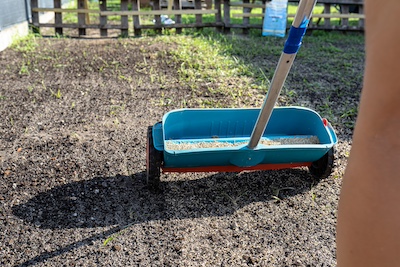When the time comes to breathe new life into your lawn through overseeding, the choice of grass seed plays a pivotal role in cultivating a lush, vibrant garden. This guide aims to simplify the selection process, breaking it down into manageable overseed steps that cater to various lawn conditions and personal preferences.
Choosing the Right Grass Seed
First, know your climate zone. Cool-season grasses like Kentucky bluegrass or perennial ryegrass are ideal for northern regions as they can withstand chilly temperatures. Warm-season grasses such as Bermuda or Zoysia are better suited for southern areas since they can handle the heat.
Next, evaluate your lawn’s sun exposure. Fully sunny areas thrive with sun-loving varieties, while shaded or partially shaded areas will do better with shade-tolerant grasses. Matching seed types to your yard’s specific conditions is key to ensuring healthy growth.
Consider soil conditions too. Before sprinkling any seeds, check your soil’s composition. Certain grass types have preferences, so this step could dictate your best choices.
Think about your lawn’s usage. For high-traffic areas, choose a hardier, resilient type. For yards that serve more as a showpiece, delicate varieties that prioritize aesthetics might be your pick.
A blend of seeds (cool-season or warm-season mix, depending on your area) can provide a well-rounded turf. These mixes offer advantages like disease resistance and adaptability to varying conditions throughout your lawn.
Consult your local garden center or a lawn care expert to further clarify your best options. With these criteria in mind, you can make an informed decision that will result in the lush, green lawn you desire.

Preparing Your Lawn for Overseeding
With the foundation for selecting the perfect grass seed laid, let’s move into preparing your lawn for overseeding. These steps ensure that your effort to overseed yields the best results.
- Test the soil. Your lawn’s soil pH may either be a cozy bed or an inhospitable place for new seedlings. Use a soil-test kit from a home improvement store. If the pH isn’t ideal, apply soil amendments like lime for acidic soil or sulfur for alkaline soil to bring it within the optimal range for grass growth.
- Mow your lawn. Cut the grass shorter than usual, about 1.5 to 2 inches. This reduces competition for light and allows new seeds to reach the soil more easily.
- Rake and remove debris. This includes dethatching, which means removing the layer of dead turfgrass and other organic material on top of the soil. A dense layer of thatch can hinder seed-to-soil contact.
- Aerate your lawn. Especially if your soil is compacted, aerating creates small holes in the soil, allowing air, water, and nutrients to access the roots more effectively. Aerated lawns provide favorable spots for new seeds to settle and sprout.
- Apply a starter fertilizer high in phosphorus. Phosphorus supports strong root development in new seedlings.1 Always follow the product’s guidelines for application rates to avoid overfeeding.
- Pre-irrigate your lawn before spreading the seeds. The soil should be moist but not soggy. Moisture is essential for germination, but too much water can wash the seeds away or cause them to rot.
With each step catered to fostering the perfect conditions, your lawn becomes a welcoming environment for new seeds to sprout and thrive.

Overseed Your Lawn and Aftercare Techniques
Once your lawn is prepped with starter fertilizer worked into the soil, it’s time to spread the seeds. Let’s walk through the steps to overseed your lawn and effectively care for it afterward.
Overseeding:
Scatter Seeds Evenly: Use a broadcast spreader or a hand-held spreader to evenly disperse the seeds across your lawn. Overlap areas slightly, especially where your grass is thinnest, to ensure complete coverage.
Gentle Watering: Right after seeding, give your lawn a gentle watering. The goal is to moisten the top layer of soil without washing away the seeds. For the first few weeks, keep the soil consistently moist with short, frequent watering sessions once or twice a day, depending on your climate.
Minimize Foot Traffic: After overseeding, keep foot traffic on the lawn as low as possible. Walking on freshly seeded areas can disrupt seed distribution and soil contact, making it harder for seeds to germinate and grow.
Post-Overseeding Care:
Continued Watering: Continue light, regular watering until the seeds germinate and the new grass starts to grow, usually 1-3 weeks. Once your new grass is established and reaches about an inch in height, reduce watering frequency but increase water depth to encourage deep root growth.
First Mow: Wait until your new grass is at least 3 inches tall before mowing. This allows the roots to become well-established. Be gentle with the mower; avoid sharp turns that can pull up new grass.
Delayed Fertilizing: Wait about four to six weeks before applying another round of fertilizer. Choose a product more balanced with nitrogen to encourage lush green growth.
Observe and Treat as Needed: As your new grass is established, watch for signs of pests or diseases. Early intervention can save your lawn from significant damage later on. Consult with a local extension office or lawn care professional for guidance if needed.
By following these steps closely, you’re investing in the health and beauty of your lawn, giving it the vigor to withstand the seasons ahead. With patience and care, those bald patches could soon be replaced by a thick, vibrant carpet of greenery.

Should You Overseed Your Lawn?
In conclusion, while the process of selecting and sowing the right grass seed might seem complex at first glance, understanding your lawn’s specific needs makes this task far more manageable. The key takeaway is that matching the seed type to your climate, soil condition, and usage can significantly increase your chances of achieving a thriving lawn. Remember, a well-chosen seed is the foundation of every green oasis.
- Pérez-Harguindeguy N, Díaz S, Garnier E, et al. New handbook for standardized measurement of plant functional traits worldwide. Aust J Bot. 2013;61(3):167-234.

